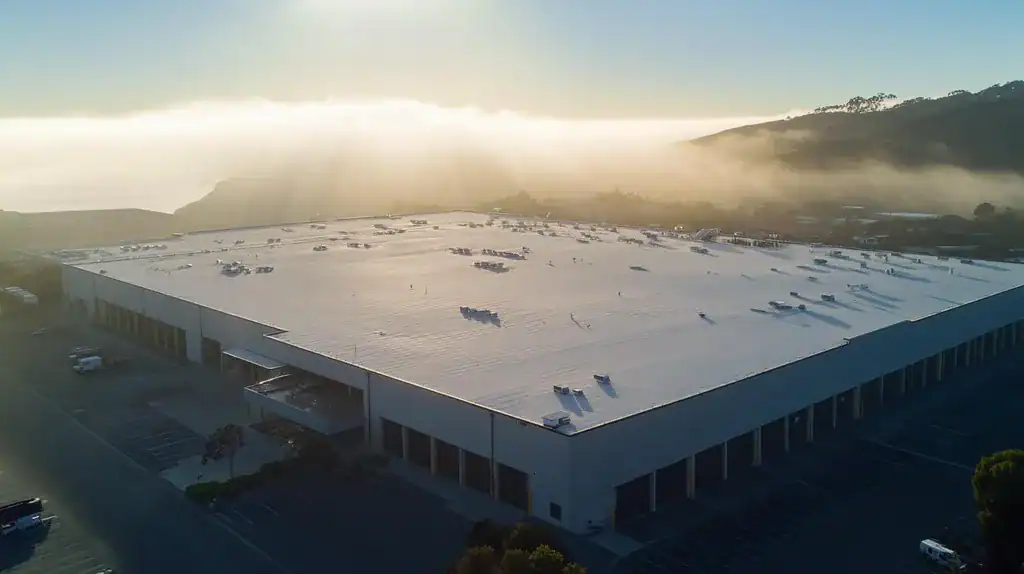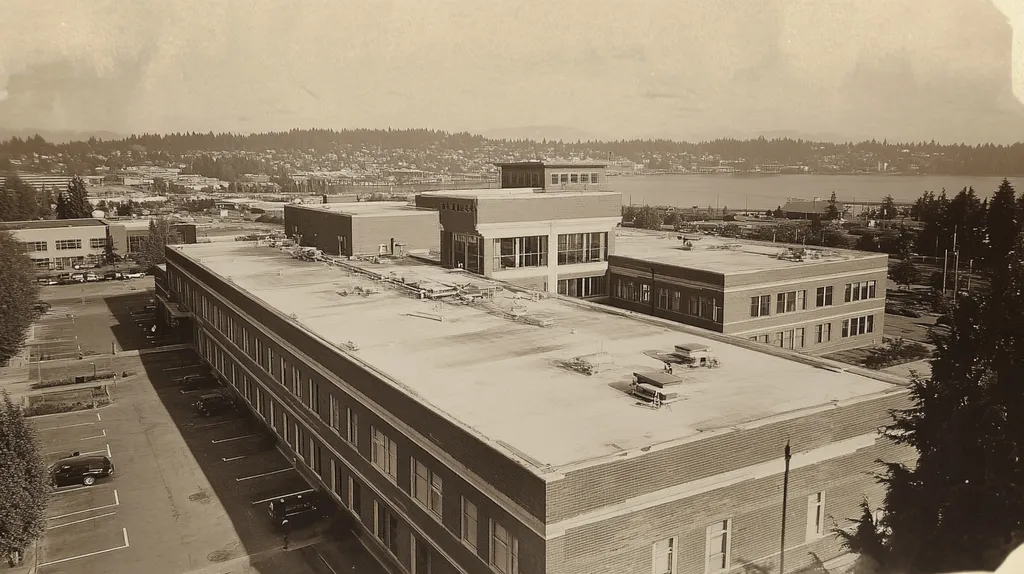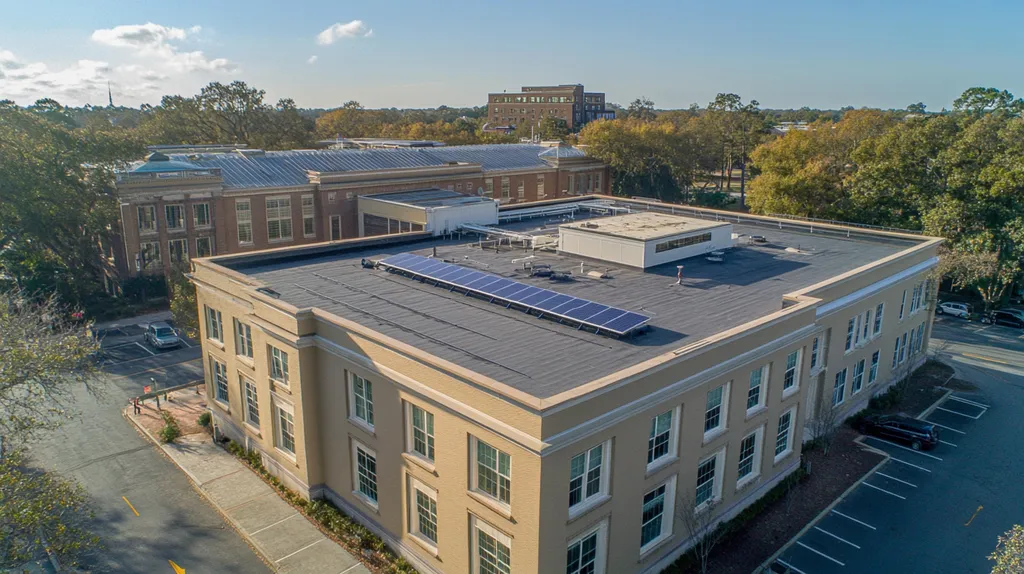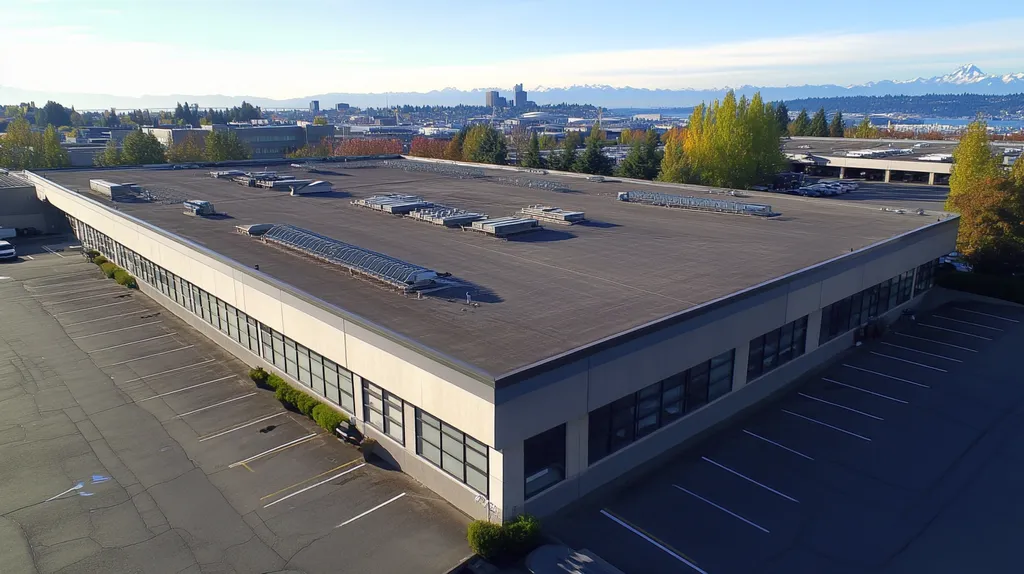Welcome to today’s Battle Royale featuring two roofing heavyweights: “TPO” in the east corner versus “PVC” in the west!
Tonight’s showdown pits these contenders against each other across six punishing rounds designed to test every aspect of their performance for Commercial Roof Lifespan Maintenance.
At stake? Millions in potential costs, decades of building protection, and the critical performance demands of modern commercial and industrial facilities.
Our professional judging panel will evaluate each round on technical merit, real-world performance, and value delivery. After all six rounds, we’ll declare our ultimate champion.
Ladies and gentlemen, facility managers and building owners… it’s time to rumble!
ROUND 1: INITIAL COSTS & INSTALLATION
The initial investment in a commercial roofing system can impact a facility’s financial health for decades. A single misstep in material selection or installation can lead to premature failure, causing extensive damage and unexpected replacement costs. Making informed decisions about materials, installation methods, and project timelines is crucial for protecting both the building and the bottom line.
Material Expenses
Material costs represent a substantial portion of any commercial roofing project. TPO membranes typically cost 20-30% less than PVC alternatives, with prices ranging from $3.50 to $5.50 per square foot for TPO compared to $5.00 to $7.50 for PVC.
TPO’s lower cost stems from simpler manufacturing processes and more abundant raw materials. However, these savings must be weighed against potential durability concerns, especially in harsh environments.
PVC’s higher price point reflects its advanced chemical formulation and proven track record in demanding applications. The material’s enhanced resistance to chemicals, oils, and environmental pollutants often justifies the premium.
Based purely on initial material expenses, TPO earns the “ADVANTAGE” in this category.
Installation Complexity
The complexity of installation directly affects labor costs and project success rates. TPO membranes are lighter and more flexible, making them easier to maneuver and position during installation.
TPO’s welding requirements are less stringent than PVC, requiring lower temperatures and shorter cooling times. This simplicity reduces the risk of installation errors and speeds up the overall process.
PVC installation demands more precise temperature control and specialized welding techniques. While these requirements enhance seam strength, they also increase the likelihood of installation complications.
The straightforward nature of TPO installation gives it a clear “ADVANTAGE” in this category.
Project Timeline
Installation speed impacts both direct costs and business disruption. TPO projects typically complete 15-25% faster than comparable PVC installations due to simpler welding procedures and easier material handling.
The rapid installation of TPO minimizes exposure to weather during the construction phase. This reduced vulnerability helps ensure proper membrane adhesion and seam integrity.
PVC installations require additional time for precise seam welding and quality control checks. While these steps enhance long-term performance, they extend project duration and increase labor costs.
TPO’s faster installation timeline earns it another “ADVANTAGE” in this category.
ROUND 1 WINNER: TPO
ROUND 2: DURABILITY & LIFESPAN
The long-term performance of commercial roofing systems hinges on their ability to withstand relentless environmental challenges. Every day, these materials face a barrage of UV radiation, temperature swings, and moisture exposure that can accelerate deterioration. Making an informed choice between TPO and PVC could mean the difference between a roof lasting 15 years versus 30 years.
Impact of UV Exposure
Ultraviolet radiation poses a constant threat to roofing membrane integrity. TPO systems initially offer excellent UV reflection but can become increasingly brittle over time, particularly in regions with intense sun exposure. This degradation often accelerates after the first decade of service.
PVC membranes incorporate advanced UV stabilizers that maintain material flexibility and strength throughout their service life. These systems typically show minimal signs of UV-related deterioration even after 20+ years of exposure.
The proven long-term UV resistance of PVC membranes earns this material the “ADVANTAGE” in this category.
Weather Impact Resistance
Commercial roofs must withstand everything from torrential rains to extreme temperature fluctuations. TPO membranes can experience accelerated aging when subjected to repeated freeze-thaw cycles, potentially leading to membrane shrinkage and seam failures.
PVC roofing systems demonstrate superior resistance to weather-related stresses, maintaining their dimensional stability and seam strength even under harsh conditions. Regular inspections can identify potential vulnerabilities before they develop into significant problems. (source: Aquila Commercial)
With its exceptional weather resistance capabilities, PVC claims another clear “ADVANTAGE” in this category.
Chemical and Environmental Resistance
Industrial environments often expose roofing materials to chemical pollutants, exhaust emissions, and acid rain. TPO membranes offer adequate chemical resistance for basic commercial applications but may show signs of degradation when exposed to harsh industrial conditions.
PVC’s molecular structure provides inherent resistance to a broad spectrum of chemicals and environmental pollutants. This chemical stability helps maintain membrane integrity even in areas with high industrial activity or air pollution.
The superior chemical resistance of PVC systems earns it the “ADVANTAGE” in this final category.
ROUND 2 WINNER: PVC
ROUND 3: PERFORMANCE FACTORS
Weather-related stresses pose an increasing threat to commercial roofing systems, with extreme conditions becoming more frequent and intense. Today’s roofing materials must withstand unprecedented challenges from UV radiation, thermal shock, and moisture intrusion that can rapidly degrade performance. Understanding how TPO and PVC respond to these environmental pressures is crucial for protecting long-term building investments.
UV Resistance
Ultraviolet radiation represents one of the most aggressive forces attacking commercial roofing systems. Daily exposure gradually breaks down chemical bonds in roofing materials, leading to surface degradation and potential system failure.
TPO membranes initially deliver excellent UV reflection and heat resistance. However, prolonged exposure often leads to surface chalking and material embrittlement, particularly in regions with intense solar exposure.
PVC systems incorporate advanced UV stabilizers and protective compounds throughout the membrane thickness. This comprehensive protection helps maintain material integrity and flexibility even after decades of sun exposure.
Based on long-term UV durability, PVC earns the “ADVANTAGE” in this category.
Thermal Cycling
Daily and seasonal temperature fluctuations create constant expansion and contraction stress on roofing materials. These thermal cycles can compromise seam integrity and accelerate aging if materials aren’t properly formulated.
TPO membranes demonstrate acceptable performance under moderate temperature variations. However, extreme temperature swings can lead to membrane shrinkage and potential seam separation over time.
PVC roofing maintains exceptional dimensional stability through temperature extremes. Its molecular structure better resists thermal fatigue, helping preserve seam strength and system waterproofing.
PVC claims another clear “ADVANTAGE” for superior thermal cycling resistance.
Moisture Resistance
Water infiltration remains the leading cause of commercial roof failures. Even minor leaks can cascade into major structural issues and costly business interruptions if left unchecked.
TPO provides effective moisture protection when properly installed and maintained. However, its seam reliability can degrade over time, especially in areas experiencing frequent precipitation or ponding water.
PVC’s hot-air welded seams create permanent molecular bonds that maintain watertight integrity throughout the system’s lifespan. This superior moisture resistance significantly reduces the risk of water-related failures.
The enhanced moisture protection of PVC earns it the final “ADVANTAGE” in this round.
ROUND 3 WINNER: PVC
ROUND 4: MAINTENANCE REQUIREMENTS
Commercial roofing maintenance requirements directly impact both operational costs and building protection. Every maintenance decision affects not just immediate repairs but the entire lifecycle cost of the roofing system. Without proper maintenance protocols, even premium roofing materials can fail prematurely, leading to costly replacements and potential structural damage.
Inspection Requirements
Regular inspections form the foundation of effective roof maintenance. TPO membranes typically require semi-annual inspections to check for seam integrity and surface wear, with additional checks after severe weather events.
These inspections can often be performed by in-house maintenance staff, as TPO’s light-colored surface makes damage identification straightforward. The material’s uniform composition also simplifies the assessment process.
PVC systems demand quarterly professional inspections due to their more complex chemical composition and potential for chemical exposure damage. These specialized inspections increase both maintenance frequency and associated costs.
Based on lower inspection requirements and simpler assessment protocols, TPO earns the “ADVANTAGE” in this category.
Repair Procedures
Over time, relentless UV radiation exposure can cause severe damage to commercial roofs, including warping, cracking, and curling of roofing materials. These issues require prompt attention to prevent system failure. (source: RebuildTX)
TPO repairs typically involve straightforward procedures using heat-welding techniques. The material’s consistent composition allows for strong, reliable repair bonds that maintain system integrity.
PVC repairs require more precise temperature control and specialized materials. While these repairs create durable solutions, they often necessitate professional contractors, increasing both cost and repair timelines.
The simpler repair requirements of TPO give it another clear “ADVANTAGE” in this category.
Long-term Maintenance Costs
Maintenance expenses over a roof’s lifetime can exceed initial installation costs. TPO systems generally require minimal chemical treatments and fewer specialized cleaning procedures, reducing ongoing maintenance budgets.
The material’s resistance to dirt accumulation and biological growth means basic cleaning methods are usually sufficient. This simplicity translates to lower long-term maintenance costs.
PVC systems often need specialized cleaning solutions and more frequent membrane treatments to maintain performance. These additional requirements can significantly impact maintenance budgets over time.
TPO’s lower long-term maintenance demands earn it the final “ADVANTAGE” in this category.
ROUND 4 WINNER: TPO
ROUND 5: SUSTAINABILITY CREDENTIALS
Today’s commercial property owners face unprecedented pressure to reduce environmental impact while maintaining building performance. With rising energy costs and stricter environmental regulations, roofing material choices can impact both operational expenses and corporate sustainability goals. The right decision between TPO and PVC roofing can mean the difference between achieving green building certifications or falling short of environmental targets.
Environmental Impact
Manufacturing processes and end-of-life disposal significantly influence a roofing system’s environmental footprint. TPO membranes require less energy to produce and generate fewer harmful emissions during manufacturing compared to alternative materials.
Most TPO formulations are 100% recyclable at the end of their service life, reducing landfill impact. The material’s lighter weight also decreases transportation emissions and installation energy requirements.
PVC production involves chlorine-based processes that release more greenhouse gases and require higher energy inputs. While some PVC can be recycled, the process is more complex and less widely available than TPO recycling.
TPO’s cleaner manufacturing process and superior recyclability earn it the “ADVANTAGE” in this category.
Energy Efficiency
Roofing systems play a crucial role in building energy performance through their solar reflectance and thermal emissivity properties. TPO membranes maintain excellent reflectivity throughout their service life, reducing cooling loads and urban heat island effects.
The naturally reflective white surface of TPO requires no additional coatings or treatments to achieve high solar reflectance index (SRI) values. This inherent reflectivity helps maintain consistent energy performance year after year.
While PVC membranes can achieve similar initial reflectivity ratings, they often require additional surface treatments that degrade over time. These treatments need regular renewal to maintain energy performance, increasing maintenance requirements and costs.
TPO’s sustained energy efficiency without additional treatments earns it the “ADVANTAGE” in this category.
Lifecycle Assessment
A complete sustainability evaluation must consider the total environmental impact throughout a material’s entire lifecycle. TPO systems typically achieve a lower overall carbon footprint when accounting for production, installation, maintenance, and disposal.
The simpler chemical composition of TPO reduces the potential for harmful emissions during installation and service life. Its durability also helps minimize the frequency of replacement and associated environmental impacts.
PVC systems carry a higher environmental burden due to their complex chemical formulation and more intensive maintenance requirements. The material’s chlorine content also raises concerns about potential environmental impacts during disposal.
TPO’s superior lifecycle environmental performance earns it the “ADVANTAGE” in this final category.
ROUND 5 WINNER: TPO
ROUND 6: SPECIALIZED APPLICATIONS
Specialized commercial roofing applications demand materials that can withstand extreme conditions while maintaining peak performance. The wrong choice between TPO and PVC in these situations can lead to premature system failure, resulting in extensive damage and costly emergency repairs. For facilities with unique requirements, understanding how these materials perform under specific conditions is crucial for protecting both the building and its contents.
Industrial Exposure
Industrial environments present unique challenges for roofing systems, including exposure to chemicals, oils, and airborne pollutants. TPO membranes offer moderate resistance to common industrial contaminants but can show accelerated degradation when exposed to harsh chemicals or petroleum products.
In these environments, TPO may require more frequent maintenance and earlier replacement, particularly in areas with direct chemical exposure. The material’s performance can be compromised by prolonged contact with industrial exhaust and processing emissions.
PVC roofing demonstrates superior resistance to industrial pollutants, maintaining its integrity even in harsh chemical environments. Its molecular structure provides natural protection against oils, greases, and most industrial chemicals.
For industrial applications, PVC earns a clear “ADVANTAGE” in this category.
High-Traffic Areas
Rooftop equipment access and maintenance activities create zones of concentrated wear that can compromise membrane integrity. TPO systems provide good puncture resistance and maintain their performance well under regular foot traffic.
The material’s flexibility helps absorb impact stress without cracking or tearing. Additional protection layers can be easily integrated into TPO systems to create dedicated maintenance paths.
PVC membranes typically demonstrate lower puncture resistance and may require more extensive reinforcement in high-traffic areas. While protective measures are available, they add complexity and cost to the installation.
TPO’s superior traffic resistance earns it the “ADVANTAGE” in this category.
Extreme Temperature Zones
Regions experiencing severe temperature fluctuations require roofing materials that maintain performance across wide thermal ranges. TPO membranes can become brittle in extreme cold and may experience accelerated aging in high-temperature environments.
These temperature-related stresses can lead to membrane shrinkage and potential seam failures. TPO’s performance limitations in extreme conditions often necessitate more frequent inspections and maintenance.
PVC systems maintain their flexibility and structural integrity across a broader temperature range. The material’s superior thermal stability helps prevent temperature-related failures and extends system longevity.
PVC claims the “ADVANTAGE” for extreme temperature performance.
ROUND 6 WINNER: PVC
AND THE WINNER IS…
After six grueling rounds of technical analysis, we have a split decision, ladies and gentlemen! With rounds split 3-3 between our contenders, we’re declaring this bout a DRAW!
TPO dominates the early rounds with knockout performances in cost efficiency, maintenance simplicity, and sustainability. Its lighter weight, easier installation, and superior energy efficiency make it the undisputed champion for budget-conscious projects where environmental impact matters.
But don’t count PVC out! This veteran fighter proves its worth in durability, weather resistance, and specialized applications. When facing harsh industrial environments or extreme temperature zones, PVC’s superior chemical resistance and thermal stability make it the clear choice.
IMPORTANT NOTICE: While this analysis covers major performance factors, every building faces unique challenges. Local climate conditions, regulatory requirements, and specific facility demands can significantly impact material performance. Property owners should always consult qualified roofing professionals who can evaluate their specific situation before making final decisions.
And there you have it, fight fans! In the commercial roofing arena, success isn’t about picking the ultimate champion – it’s about matching your facility’s specific requirements with the right contender’s strengths. Choose wisely, and may your roof reign supreme for decades to come!
FREQUENTLY ASKED QUESTIONS
Q. What are the initial costs of a commercial roof system?
A. Material expenses vary, with TPO generally costing less than PVC. However, consider installation complexity and long-term maintenance when budgeting to avoid unexpected expenses.
Q. How does weather affect the lifespan of an industrial roof?
A. Weather elements like UV exposure and temperature fluctuations significantly impact durability. Choosing the right material can extend lifespan and reduce maintenance costs over time.
Q. What maintenance is required for a commercial roof?
A. Regular inspections are crucial for all roofing types. TPO typically needs semi-annual checks, while PVC requires quarterly inspections for optimal performance and longevity.
Q. Which material is more durable for commercial roofing?
A. PVC is generally more durable in harsh environments than TPO. Its resistance to UV radiation and chemicals contributes to a longer lifespan in demanding conditions.
Q. What are the energy efficiency benefits of commercial roofs?
A. TPO membranes reflect sunlight effectively, helping reduce energy costs. This contributes to improved building energy efficiency and lower cooling loads throughout the summer months.
Q. How do industrial roofs perform in extreme temperatures?
A. PVC roofing performs better in extreme temperatures. It maintains flexibility and strength when exposed to both high heat and freezing conditions, unlike TPO, which may become brittle.
Q. Can I recycle commercial roofing materials?
A. Yes, many TPO materials are 100% recyclable, making them a more environmentally friendly option. Recycling policies and availability can vary by region for PVC materials.










